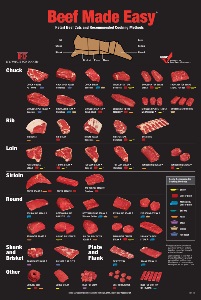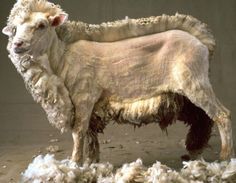Five by Products of Beef Industry

Feeding the World
Having food security means having a safe, plentiful food supply for all people. It is a huge goal, so animal scientists are working to improve the supply of animal products.
Products From Animals
Animals play very important roles in our lives. Animals are pets, they are raised as food and they provide products important to everyday life. You may not realize how many things come from animals.
Pigs
Pork is the most widely consumed meat in the world. People eat many different pork products, such as bacon, sausage and pork chops. You might grill pork ribs in the summer, or you might enjoy a Christmas ham. A 250 pound market hog yields about 150 pounds of pork. In addition to pork, several valuable products come from swine. These include insulin for the regulation of diabetes, valves for human heart surgery, suede for shoes and clothing, and gelatin for foods and non-food uses. Swine by-products are also important parts of products such as water filters, insulation, rubber, antifreeze, certain plastics, floor waxes, crayons, chalk, adhesives and fertilizer (USDA, 2016). Lard is fat from pig abdomens and is used in shaving creams, soaps, make-up, baked goods and other foods.

Everything but the oink: The many products that come from pig.
Cattle
"Beef: It's what for dinner" is a phrase that you might hear in commercials. So what products do beef animals give us? Beef cattle provide different cuts of meat that many of us eat every day. These include ribs, steak, fillet mignon and ground beef. Take a look at the picture to learn more.
Dairy cows are another type of cattle that provide us with nutritional products. There are many different dairy products but some you might be most familiar with include milk, cheese, yogurt, butter and ice cream. Other dairy products include sour cream, cottage cheese, whey, cream cheese and condensed milk. Dairy products are often used in cooking and baking and contain calcium, which can help to strengthen your bones.
When dairy animals can no longer produce milk, they are often used for meat, primarily in the form of ground beef. It is possible to get the same cuts of meat from a dairy cow that you do a beef animal. Male dairy calves, called bull calves, that are not used for beef are often used for veal. Veal is meat from younger animals and is very lean. It is considered a delicacy in many countries.
There are various by-products that come from all types of cattle. Tallow is fat from cattle, and it is used in wax paper, crayons, margarine, paints, rubber, lubricants, candles, soaps, lipsticks, shaving creams and other cosmetics.
Gelatin is a protein obtained by boiling skin, tendons, ligaments, and/or bones of cattle in water. Gelatin is used in shampoos, face masks and other cosmetics. Gelatin is also used in foods as a thickener for fruit gelatins and puddings (like Jell-O), candies and marshmallows.
Leather comes from the hides of animals. It is used to make wallets, purses, furniture, shoes and car upholstery. Leather can be made from the skin of pigs, cattle, sheep, goats and exotic species such as alligators.

Poultry
Poultry meat, broiler meat in particular, has the highest per-capita consumption in the United States. Meat from chickens can come in many different forms such as BBQ, wings, nuggets, boneless, roasted or fried, just to name a few. Chickens also produce eggs which serve as a source of protein and are used in baking. Click here to see the egg's journey from farm to plate. Eggs are also used for the production of therapeutic vaccines and are beginning to be used for production of antibodies and pharmacological proteins.
Some lesser-known members of the poultry family include turkeys, ducks and geese. We use all three of these animals for meat production. Turkeys are most famous for their use as the centerpiece at Thanksgiving. Turkey is growing in popularity as a lean protein and alternative products, such as turkey bacon and sausage, are available.
The eggs from all three of these species are safe to eat; they are sometimes just larger in size or a different color than traditional chicken eggs. Feathers from ducks and geese are also used as stuffing (down) in jackets and pillows.
Sheep
Sheep produce a wide variety of items that people use. Like cows, sheep produce milk that is safe for people to drink. This milk can be made into cheese, yogurt and various other dairy products.
Sheep provide meat in the form of lamb, which is from an animal less than a year old, or mutton, which is from an animal older than a year. Sheep meat is mainly consumed in Europe and the Mid-East, but sheep are mainly raised in Australia and New Zealand.
Other than meat, wool is one of the most commonly known products from sheep. Wool is sheep hair that is shaved off during hot weather. After processing, wool can be made into lots of different things, such as shirts, socks, yarn for knitting and tennis ball covers. Wool is also used as an oil absorbent in oil spills.
After slaughter, sheep skins are turned into leather used in car upholstery, clothing and shoes. The bones, hooves and horns of sheep are also used to make products such as gelatin, tape, brushes and pet food ingredients.

Sheep Shearing
Goats
Meat from goats is a type of red meat and can come in many different cuts from the animal. Goat meat is not widely consumed in the United States, but it is a popular protein source in developing countries.
Goats also produce milk that can be made into cheese, yogurt, soap and baby formula. Goat's milk is a good replacement for babies who are allergic to cow's milk.
Soft cashmere comes from the wool of certain types of goats called cashmere goats. Other types of goats, such as Angora goats, also produce wool, but it is a different texture than cashmere. All wools can be used to make clothing such as sweaters, socks and scarves.
Horses
Typically horses are thought of as fun animals to ride, or to help farmers herd animals. However, there are other uses for horses that vary around the world. In the country of Kazakhstan, milk from horses is consumed and is often fermented into a drink called Kumis. Meat from horses is also consumed in many countries around the world. Horse meat is popular in the region of Central Asia.
Rabbits
You may be surprised to learn that rabbits provide fur and meat. Angora rabbits are a type of rabbit that have long fur. People obtain their fur by combing them. This fur can be turned into yarn, socks and other clothing. Rabbits can also be raised for meat.
Fish and seafood
The oceans, lakes, rivers and streams of the world provide us with different types of nutritious foods. Fish serve as a source of protein. Fish eggs, called caviar, are also used as food and are considered a delicacy. Fish oils are a by-product of fish and are said to improve mental health, decrease the risk of cancer and increase heart health. Seafood can also include products such as shrimp, squid, mussels, clams and crab.
Bees
Bees play a vital role in the food you eat even if you may not realize it. Honey bees help crops grow by pollinating plants. The value of honey bee pollination in U.S. agriculture is more than 14 billion dollars annually. Bees also make honey from the nectar of plants which is collected by bee keepers. Honey can be used as an all-natural sweetener and in hand lotions, soaps, natural cough suppressant and also as a natural form of energy. Honey is also a source of the carbohydrates that provide energy to your muscles. Bees also produce beeswax which is used to make candles, lipstick, lotions, shoe polish, crayons, chewing gum and floor wax.
You might have known about meat, milk and eggs, but did you ever realize how many other products there are from animals? When we use by-products from animals, we can reduce waste and be more environmentally friendly. We are able to take items that would otherwise be thrown away and turn them into something that benefits society.
References
https://www.ers.usda.gov/topics/animal-products/hogs-pork/
https://www.ers.usda.gov/topics/animal-products/cattle-beef/
https://www.ers.usda.gov/topics/animal-products/poultry-eggs/
https://www.ers.usda.gov/topics/animal-products/sheep-lamb-mutton/background/
http://www.ansi.okstate.edu/breeds/goats/cashmere
http://astanatimes.com/2013/04/scientists-develop-kumis-products-for-export/
https://www.fsis.usda.gov/wps/wcm/connect/bcb4cfe5-4af2-4406-8ab9-4a1c8273dff5/Rabbit_from_Farm_to_Table.pdf?MOD=AJPERES
https://www.ars.usda.gov/plains-area/gfnd/gfhnrc/docs/news-2013/fish-oils-are-good-for-your-health/
http://oklahoma4h.okstate.edu/aitc/lessons/extras/facts/honey.html

A Jr. Animal Scientist membership is a great way for kids to learn about science and the animal world.
Through the Jr. Animal Scientist magazine and special online resources, kids can learn about pets, farm animals and zoo animals. Scientific information is tailored for kids ages 5 to 9 (K-3rd grades). Eye-catching photos and exciting animal activities add to the fun! Plus, all Jr. Animal Scientists get special prizes just for joining.

Source: https://animalsmart.org/feeding-the-world/products-from-animals
0 Response to "Five by Products of Beef Industry"
Post a Comment